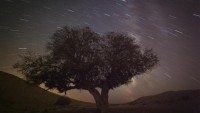September Astronomy: Enjoy Equinox and Watch Celestial Rivals in the Sky
| Kizha T. Trovillas | | Sep 02, 2014 07:35 AM EDT |
(Photo : http://upload.wikimedia.org/wikipedia/commons/c/c9/Sirius_A_and_B_artwork.jpg)
For those looking forward to the delights the month of September has to offer, you don't have to wait any longer.
Catch Mars zooming across the sky for the entire month and meeting up with other heavenly bodies including the Moon, Saturn and the brightest stars.
The September equinox will also complete the treat, marking the official start of autumn.
Like Us on Facebook
Conjunction between Planets and Other Stars
Mars will show off captivating views with other objects in the southwest night sky, as the Red Planet moves five degrees from Saturn on the first of September.
According to the astronomy weblog The Space Reporter, Saturn appears yellow through a telescope and its rings are tipped 22 degrees from edge on. The planet will also set earlier in the southwest to west-southwest each evening as the month advances.
On Sept 5 and 6, three stars will position about midway between Mars and the star Antares, which is the distinctly reddish star viewed as the rival of Mars. Antares means "equal to Ares" with Aries as the Greek name of Mars.
By Sept 12, the Red Planet will move equidistant between Saturn and Antares, with approximately 11 degrees from each other.
Mars will also pass north of Delta Scorpii in a half degree by Sept 17 and on Sept 27, the planet will pass three degrees north of Antares with a bonus crescent moon nearby two nights later.
Jupiter and Venus will also shine brightest in the early mornings before dawn. The crescent moon will be south of Jupiter before sunrise of Sept 20 while Venus will gradually disappear by the end of the month.
The Third Supermoon of the Year with Equinox
The full moon that will shine the night on the 9th of September at 1:38 UTC will be the third consecutive supermoon of 2014, which is also known as the "harvest moon."
Closest to the autumnal equinox, the harvest moon will rise further north on the horizon at nighttime after it is full. Traditionally, this gives farmers a light source to work late in the early evenings during harvest time as the phenomenon lessens the usual delay between successive moonrises.
According to U.S. Naval Observatory, the autumnal equinox will arrive two weeks later on Sept 23 at 2:29 a.m., UTC.
During equinox, the Earth's axis will tilt neither away from nor toward the Sun. This happens as the sun crosses the celestial equator from north to south.
Night and day will be nearly of the same length, which will be approximately 12 hours.
Enjoy!
TagsSpace Reporter, harvest moon, supermoon, euinox, autumnal equinox
©2015 Chinatopix All rights reserved. Do not reproduce without permission
EDITOR'S PICKS
-

Did the Trump administration just announce plans for a trade war with ‘hostile’ China and Russia?
-

US Senate passes Taiwan travel bill slammed by China
-

As Yan Sihong’s family grieves, here are other Chinese students who went missing abroad. Some have never been found
-

Beijing blasts Western critics who ‘smear China’ with the term sharp power
-

China Envoy Seeks to Defuse Tensions With U.S. as a Trade War Brews
-

Singapore's Deputy PM Provides Bitcoin Vote of Confidence Amid China's Blanket Bans
-

China warns investors over risks in overseas virtual currency trading
-

Chinese government most trustworthy: survey
-

Kashima Antlers On Course For Back-To-Back Titles
MOST POPULAR
LATEST NEWS
Zhou Yongkang: China's Former Security Chief Sentenced to Life in Prison

China's former Chief of the Ministry of Public Security, Zhou Yongkang, has been given a life sentence after he was found guilty of abusing his office, bribery and deliberately ... Full Article
TRENDING STORY

China Pork Prices Expected to Stabilize As The Supplies Recover

Elephone P9000 Smartphone is now on Sale on Amazon India

There's a Big Chance Cliffhangers Won't Still Be Resolved When Grey's Anatomy Season 13 Returns

Supreme Court Ruled on Samsung vs Apple Dispute for Patent Infringement

Microsoft Surface Pro 5 Rumors and Release Date: What is the Latest?













